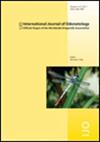铁纹异足虫的生命周期(Fabricius,1775)(Odinata:Libellulidae)
IF 1
4区 农林科学
Q3 ENTOMOLOGY
引用次数: 0
摘要
首次描述了铁齿龙的完整生命周期,代表了墨西哥齿龙的第一个完整生命周期。获得的17个幼虫龄被详细描述和说明,从prolarva到F-0。在野外采集了两批不同雌性的卵子,随后在实验室饲养。各批次的卵和幼虫在26°C的控制温度条件下饲养,直到达到F-6和F-5龄。为了完成F-5的生命周期,额外收集了野生生物。只有四只野生幼虫在30°C下完成了最后五个缺失的幼虫龄期。最年轻龄(F-15至F-8)的幼虫被喂食方卤虫的无节幼体,而F-7至F-0则被喂食库蚊科和摇蚊科的幼虫。从F-0到F-16的幼虫生命周期平均持续186天。本文章由计算机程序翻译,如有差异,请以英文原文为准。
The life cycle of Orthemis ferruginea (Fabricius, 1775) (Odonata: Libellulidae)
The complete life cycle of O. ferruginea is described for the first time, represent the first complete life cycle described for an odonate in Mexico. The 17 larval instars obtained are described and illustrated in detail, from prolarva through F-0. Two egg batches of different females were obtained in the field and were subsequently reared in the laboratory. Eggs and larvae of the batches were raised under 26°C controlled temperature conditions until they reached instars F-6 and F-5. An extra collection of wild organisms was made in order to complete the life cycle from F-5. Only four of the wild larvae managed to complete the last five missing larval instars at 30°C. Larvae of the youngest instars (F-15 to F-8) were fed nauplii of Artemia franciscana, while F-7 to F-0 were fed larvae of Culicidae and Chironomidae. Larval life cycle from F-0 to F-16 lasted average of 186 days.
求助全文
通过发布文献求助,成功后即可免费获取论文全文。
去求助
来源期刊

International Journal of Odonatology
ENTOMOLOGY-
CiteScore
2.30
自引率
0.00%
发文量
15
审稿时长
>12 weeks
期刊介绍:
International Journal of Odonatology (IJO) is aimed at providing a publication outlet for the growing number of students of Odonata. It will address subjects such as the ecology, ethology, physiology, genetics, taxonomy, phylogeny and geographic distribution of species. Reviews will be by invitation, but authors who plan to write a review on a subject of interest to the journal are encouraged to contact the editor.
 求助内容:
求助内容: 应助结果提醒方式:
应助结果提醒方式:


